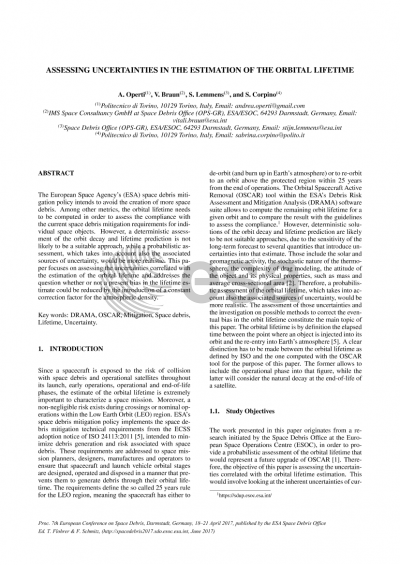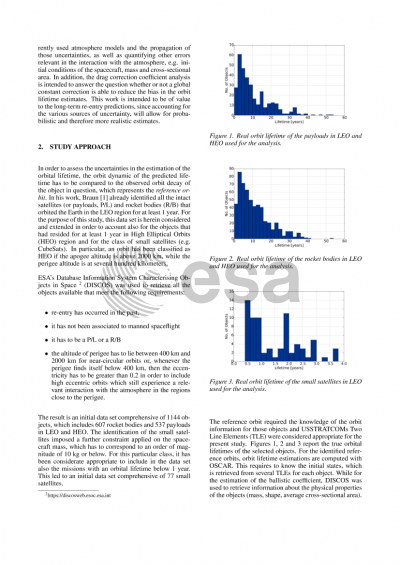Document details

Abstract
Since a spacecraft is exposed to the risk of collision with orbital debris and operational satellites throughout its launch, early orbit, operational and end-of-life phases, the estimate of the orbital lifetime is extremely important to characterize a space mission. Indeed, with European Space Agency's (ESA) space debris mitigation policy came into force in March 2014 and its intention being to reduce the growth of space debris, the orbital lifetime needs to be computed in order to assess the compliance with the current space debris mitigation requirements.
The Orbital Spacecraft Active Removal (OSCAR) tool within the ESA's Debris Risk Assessment and Mitigation Analysis (DRAMA) software suite allows to compute the remaining lifetime for a given object. The semi-analytical propagator will forecast the orbit evolution, considering the selected solar and geomagnetic activity scenario and all the relevant perturbations. The resulting estimate is then compared with the guidelines. However, a deterministic assessment of the orbit decay and lifetime prediction is likely not to be a suitable approache, due to the sensitivity of the long-term forecast to several quantities that introduce uncertainties into that estimate.
Those include: the solar and geomagnetic activity, the stochastic nature of the thermosphere, the complexity of drag modeling, the attitude of the object and its physical properties, such as mass and cross-sectional area.
As consequence, a probabilistic assessment of the orbital lifetime, which takes into account also the associated sources of uncertainty, would be more realistic.
This paper will provide first an overview on the initial data set and tools used for the analysis, focusing then on assessing the uncertainties correlated with the estimation of the orbital lifetime. This work also addresses the question whether or not a present bias in the lifetime estimate could be reduced with a constant correction factor.
The investigation takes in consideration objects whose re-entry occurred in the past, which allows to exclude the solar and geomagnetic activity as a source of uncertainty. The objects are subdivided according to the eccentricity of the orbit, namely LEO and HEO, since the relevant decay characteristics can be different for those regions. The US Naval Research Laboratory Mass Spectrometer and Incoherent Scatter Radar (NRLMSISE-00) and the Drag Temperature Model (DTM2013) atmosphere models are used to model the thermospheric density, the former because of its popularity, while the latter incorporates the most recent data acquired with in-situ measurements.
The bias in the orbital lifetime is evaluated in terms of relative error, by comparing the estimated value to the observed or true lifetime. The analysis is performed considering for each object a set of constant correction coefficients applied to the modelled drag force. For each object, the correction factor that best approximate the lifetime is identified.
The results reveal the sensitivity of OSCAR lifetime estimates when the current model’s state-of-the-art is used for the forecast. In particular, the work shows the importance of having reliable data on the physical properties of the objects, as well as their influence on the prediction and the best correction coefficient. It also points out that assessing the uncertainties and the sensitivity of the lifetime estimate is important in evaluating the compliance with space debris mitigation requirements.
Preview








